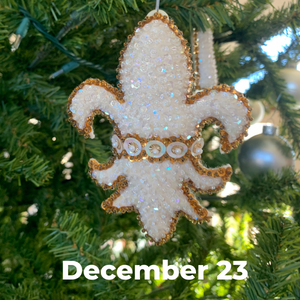December 23, 2021

The Fleur De Lis
The Fleur De Lis represents the Virgin Mary.
The virgin will conceive and give birth to a son, and they will call him Immanuel.
Matthew 1:23
A few weeks ago, we attended a concert by Franco-Flemish composers from the 15th and 16th centuries. The composers during that period were intensely experimenting by layering harmony, rhythm and counter melodies that would burst forth a century later into a rousing Baroque cacophony.
Among the works that were performed was a tribute to the Virgin Mary, in which composer Josquin des Prez (c. 1450-1521) describes her as “lily, flower of the humble, noble virgin….” The lily reminds us of Jesus’ virgin birth – deep and unexplainable by our common understanding.
So, why a lily?
Look no further than a Georgia O’Keeffe painting – the lily petals wrap exquisitely layer upon layer in an unexplainable swirl of paint strokes. We don’t know how the artist achieves such depth, but we can revel in the mystery of her creation.
How does this happen?
The fleur de lis (in French, “flowering lily”) is a carefully drawn symbol of the virgin and her son, consisting of three petals entwining into a bursting revelation of color and texture. The lily’s three petals establish a clear connection with the three persons of the Trinity. Historically, the three petals have also been associated with faith, wisdom, and service to others – as if to solve the mystery.
Yet, questions remain.
Josquin des Prez tries to balance his musical imagery of the Virgin with the lily: “By the Holy Spirit’s power this heavenly work has been brought about. The beginning and end of your giving birth who can really know? By God’s grace, which orders all things so smoothly your childbearing confronts us with a mystery. Hail Mary.”
Theologians may attempt to answer why the Virgin Mary is important and how three can become one. The truth can simply be found in 1 Corinthians 15:51-53: “Listen, I tell you a mystery: We will not all sleep, but we will all be changed—in a flash, in the twinkling of an eye, at the last trumpet. For the trumpet will sound, the dead will be raised imperishable, and we will be changed. For the perishable must clothe itself with the imperishable, and the mortal with immortality.”
Patty Benoit